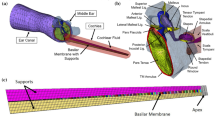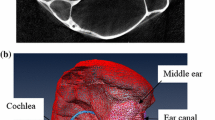Abstract
Blast-induced auditory trauma is a common injury in military service members and veterans that leads to hearing loss. While the inner ear response to blast exposure is difficult to characterize experimentally, computational models have advanced to predict blast wave transmission from the ear canal to the cochlea; however, published models have either straight or spiral cochlea with fluid-filled two chambers. In this paper, we report the recently developed 3D finite element (FE) model of the human ear mimicking the anatomical structure of the 3-chambered cochlea. The model consists of the ear canal, middle ear, and two and a half turns of the cochlea with three chambers separated by the Reissner’s membrane (RM) and the basilar membrane (BM). The blast overpressure measured from human temporal bone experiments was applied at the ear canal entrance and the Fluent/Mechanical coupled fluid–structure interaction analysis was conducted in ANSYS software. The FE model-derived results include the pressure in the canal near the tympanic membrane (TM) and the intracochlear pressure at scala vestibuli, the TM displacement, and the stapes footplate (SFP) displacement, which were compared with experimentally measured data in human temporal bones. The validated model was used to predict the biomechanical response of the ear to blast overpressure: distributions of the maximum strain and stress within the TM, the BM displacement variation from the base to apex, and the energy flux or total energy entering the cochlea. The comparison of intracochlear pressure and BM displacement with those from the FE model of 2-chambered cochlea indicated that the 3-chamber cochlea model with the RM and scala media chamber improved our understanding of cochlea mechanics. This most comprehensive FE model of the human ear has shown its capability to predict the middle ear and cochlea responses to blast overpressure which will advance our understanding of auditory blast injury.








Similar content being viewed by others
References
Bien, A. G., S. Jiang, and R. Z. Gan. Real-time measurement of stapes motion and intracochlear pressure during blast exposure. Hear. Res. 429:1–11, 2023.
Böhnke, F., and W. Arnold. 3D-Finite element model of the human cochlea including fluid-structure couplings. ORL. 61:305–310, 1999.
Brown, M. A., J. J. Bradshaw, and R. Z. Gan. Three-dimensional finite element modeling of blast wave transmission from the external ear to a spiral cochlea. J. Biomech. Eng. 144:014503, 2022.
Brown, M. A., X. D. Ji, and R. Z. Gan. 3D Finite element modeling of blast wave transmission from the external ear to cochlea. Ann. Biomed. Eng. 49:757–768, 2021.
Cheng, T., C. Dai, and R. Z. Gan. Viscoelastic properties of human tympanic membrane. Ann. Biomed. Eng. 35:305–314, 2007.
Cooper, N. P., and W. S. Rhode. Nonlinear mechanics at the apex of the guinea-pig cochlea. Hear. Res. 82:225–243, 1995.
De Paolis, A., M. Bikson, J. T. Nelson, J. A. de Ru, M. Packer, and L. Cardoso. Analytical and numerical modeling of the hearing system: advances towards the assessment of hearing damage. Hear. Res. 349:111–128, 2017.
Dewey, J. M. The air velocity in blast waves from t.n.t. explosions. Proc. R. Soc. Lond. A. 279:366–385, 1964.
Elliott, S. J., G. Ni, B. R. Mace, and B. Lineton. A wave finite element analysis of the passive cochlea. J. Acoust. Soc. Am. 133:1535–1545, 2013.
Gan, R. Z., B. Feng, and Q. Sun. Three-dimensional finite element modeling of human ear for sound transmission. Ann. Biomed. Eng. 32:847–859, 2004.
Gan, R. Z., and S. Jiang. Surface motion changes of tympanic membrane damaged by blast waves. J. Biomech. Eng. 141:091009, 2019.
Gan, R. Z., D. Nakmali, X. D. Ji, K. Leckness, and Z. Yokell. Mechanical damage of tympanic membrane in relation to impulse pressure waveform—a study in chinchillas. Hear. Res. 340:25–34, 2016.
Gan, R. Z., B. P. Reeves, and X. Wang. Modeling of sound transmission from ear canal to cochlea. Ann. Biomed. Eng. 35:2180–2195, 2007.
Gan, R. Z., Q. Sun, B. Feng, and M. W. Wood. Acoustic–structural coupled finite element analysis for sound transmission in human ear—pressure distributions. Med. Eng. Phys. 28:395–404, 2006.
Greene, N. T., M. A. Alhussaini, J. R. Easter, T. F. Argo, T. Walilko, and D. J. Tollin. Intracochlear pressure measurements during acoustic shock wave exposure. Hear. Res. 365:149–164, 2018.
Herrmann, G., and H. Liebowitz. Chapter 10 - Mechanics of Bone Fracture. In: Fracture of Nonmetals and Composites, edited by H. Liebowitz. Academic Press, 1972, pp. 771–840. https://doi.org/10.1016/B978-0-12-449707-8.50014-2
Hickman, T. T., C. Smalt, J. Bobrow, T. Quatieri, and M. C. Liberman. Blast-induced cochlear synaptopathy in chinchillas. Sci. Rep. 8:10740, 2018.
Jiang, S., C. Dai, and R. Z. Gan. Dual-laser measurement of human stapes footplate motion under blast exposure. Hear. Res. 403:108177, 2021.
Jiang, S., K. Smith, and R. Z. Gan. Dual-laser measurement and finite element modeling of human tympanic membrane motion under blast exposure. Hear. Res. 378:43–52, 2019.
Kim, S. H., K. X. Kim, N. N. Raveendran, T. Wu, S. R. Pondugula, and D. C. Marcus. Regulation of ENaC-mediated sodium transport by glucocorticoids in Reissner’s membrane epithelium. Am. J. Physiol. Cell Physiol. 296:14, 2009.
Kirikae, I. The Structure and Function of the Middle Ear. Tokyo: University of Tokyo Press, 1960.
Leckness, K., D. Nakmali, and R. Z. Gan. Computational modeling of blast wave transmission through human ear. Mil. Med. 183:262–268, 2018.
Lee, J. H., and D. C. Marcus. Endolymphatic sodium homeostasis by REISSNER’s membrane. Neuroscience. 119:3–8, 2003.
Liu, W., F. Atturo, R. Aldaya, P. Santi, S. Cureoglu, S. Obwegeser, R. Glueckert, K. Pfaller, A. Schrott-Fischer, and H. Rask-Andersen. Macromolecular organization and fine structure of the human basilar membrane—RELEVANCE for cochlear implantation. Cell Tissue Res. 360:245–262, 2015.
Olson, E. S., H. Duifhuis, and C. R. Steele. Von Békésy and cochlear mechanics. Hear. Res. 293:31–43, 2012.
Paik, C. B., M. Pei, and J. S. Oghalai. Review of blast noise and the auditory system. Hear. Res. 2022. https://doi.org/10.1016/j.heares.2022.108459.
Price, G. R. Validation of the auditory hazard assessment algorithm for the human with impulse noise data. J. Acoust. Soc. Am. 122:2786, 2007.
Price, G. R. Predicting mechanical damage to the organ of Corti. Hear. Res. 226:5–13, 2007.
Reichenbach, T., A. Stefanovic, F. Nin, and A. J. Hudspeth. Waves on Reissner’s membrane: a mechanism for the propagation of otoacoustic emissions from the cochlea. Cell Rep. 1:374–384, 2012.
Sun, Q., R. Z. Gan, K.-H. Chang, and K. J. Dormer. Computer-integrated finite element modeling of human middle ear. Biomech. Model. Mechanobiol. 1:109–122, 2002.
Yu, Y.-C., T.-C. Wang, and T.-C. Shih. A comprehensive finite-element human ear model to estimate noise-induced hearing loss associated with occupational noise exposure. Comput. Methods Programs Biomed. 226:107179, 2022.
Zhang, X., and R. Z. Gan. A Comprehensive model of human ear for analysis of implantable hearing devices. IEEE Trans. Biomed. Eng. 58:3024–3027, 2011.
Zhang, X., and R. Z. Gan. Finite element modeling of energy absorbance in normal and disordered human ears. Hear. Res. 301:146–155, 2013.
Acknowledgements
The work was supported by Department of Defense (DoD) Grant No. W81XWH-14-1-0228.
Author information
Authors and Affiliations
Corresponding author
Additional information
Associate Editor Joel Stitzel oversaw the review of this article.
Publisher's Note
Springer Nature remains neutral with regard to jurisdictional claims in published maps and institutional affiliations.
Rights and permissions
Springer Nature or its licensor (e.g. a society or other partner) holds exclusive rights to this article under a publishing agreement with the author(s) or other rightsholder(s); author self-archiving of the accepted manuscript version of this article is solely governed by the terms of such publishing agreement and applicable law.
About this article
Cite this article
Bradshaw, J.J., Brown, M.A., Jiang, S. et al. 3D Finite Element Model of Human Ear with 3-Chamber Spiral Cochlea for Blast Wave Transmission from the Ear Canal to Cochlea. Ann Biomed Eng 51, 1106–1118 (2023). https://doi.org/10.1007/s10439-023-03200-6
Received:
Accepted:
Published:
Issue Date:
DOI: https://doi.org/10.1007/s10439-023-03200-6




